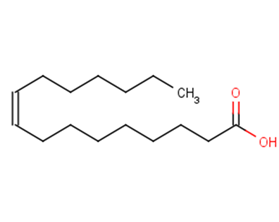
Palmitoleic acid
CAS No. 373-49-9
Palmitoleic acid( (Z)-Hexadec-9-enoic acid | (Z)-9-hexadecenoic acid )
Catalog No. M19746 CAS No. 373-49-9
Palmitoleic acid is found to be associated with isovaleric acidemia which is an inborn error of metabolism.
Purity : >98% (HPLC)
 COA
COA
 Datasheet
Datasheet
 HNMR
HNMR
 HPLC
HPLC
 MSDS
MSDS
 Handing Instructions
Handing Instructions
| Size | Price / USD | Stock | Quantity |
| 50MG | 41 | In Stock |


|
| 100MG | 65 | In Stock |


|
| 500MG | 158 | In Stock |


|
| 1G | Get Quote | In Stock |


|
Biological Information
-
Product NamePalmitoleic acid
-
NoteResearch use only, not for human use.
-
Brief DescriptionPalmitoleic acid is found to be associated with isovaleric acidemia which is an inborn error of metabolism.
-
DescriptionPalmitoleic acid is found to be associated with isovaleric acidemia which is an inborn error of metabolism.
-
In Vitro——
-
In Vivo——
-
Synonyms(Z)-Hexadec-9-enoic acid | (Z)-9-hexadecenoic acid
-
PathwayProteasome/Ubiquitin
-
TargetEndogenous Metabolite
-
RecptorHuman Endogenous Metabolite
-
Research Area——
-
Indication——
Chemical Information
-
CAS Number373-49-9
-
Formula Weight254.41
-
Molecular FormulaC16H30O2
-
Purity>98% (HPLC)
-
SolubilityDMSO:10 mM;Water:1mg/mL
-
SMILESCCCCCC\C=C/CCCCCCCC(O)=O
-
Chemical Name——
Shipping & Storage Information
-
Storage(-20℃)
-
ShippingWith Ice Pack
-
Stability≥ 2 years
Reference
1.Ogunleye A et al. Fatty acid composition of breast milk from Nigerian and Japanese women. J Nutr Sci Vitaminol (Tokyo). 1991 Aug;37(4):435-42.
molnova catalog



related products
-
S-(2-Carboxypropyl)c...
S-(2-Carboxypropyl)cysteine is a urinary metabolite of S-(2-Carboxypropyl)glutathione.
-
Methyl 4-anisate
Methyl anisate is an endogenous metabolite.
-
Lactoferrin
Lactoferrin is secreted by mammals and displays extensive biological effects including boosting the cold tolerance of a well-applied probiotic strain.



 Cart
Cart
 sales@molnova.com
sales@molnova.com


